



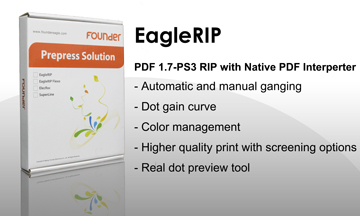
EagleRIP at a Glance
A RIP (Rasterized Image Processor) is a system that converts page description language to rasterized image and outputs to an imaging device.
Founder began research on RIP technology since 1975. Founder’s EagleRIP Flexo is a native PDF interpreter, with high speed performance, advanced screening technology and good layout application compatibility. EagleRIP Flexo not only supports flexo printing, but also supports offset printing.
PDF 1.7 - PostScript 3 for superb quality documents
Founder’s EagleRIP creates superb quality PDF and PostScript jobs. Complex documents, vivid colors, transparent objects, files with embedded ICC profiles and smooth shading are consistently processed to meet the high standards of the most demanding customer. EagleRIP provides support for features within PDF 1.7 and PostScript 3.
Performance of screening technology that meets your needs of Flexo
Ensure output quality while reducing errors with fast, flexible and detailed screen previews and dot previews
Ensure the output is accurate by digitally previewing color and dot shape prior to committing to physical output. EagleRIP lets you preview color separations and composites, and includes preview functions such as Zoom, Negative, Mirror, Rotate and Screen preview of the bitmap dot.
Higher quality print with screening options
EagleRIP screen dot shapes allow users to select the dot that ensures maximum printing quality. Nine standard screenings include Euclidean Round, Rhomb, Ellipse, Diamond, Pure Round, Sharp Ellipse, Square, Cross and FM screening. Optional screenings such as EagleAM, EagleFM, EagleFAM (AM & FM hybrid printing) and EagleAGS (gravure printing) are available as plug-ins.
EagleAM screening option
Adopts new screen angle technology (+/- 7.5) comparing to the traditional AM screening angle (15, 45, 90, 75). 
a. Improves the rosette pattern, gray level is exquisite and smooth.
b. More accurate angles produces higher quality.
c. Better reproduction of gradient shading and overprint effect of tints and skin color.
d. Suitable for printing high frequency images on CTP (greater than 300LPI).
EagleFM screening option
Base on green noise FM technology & Founder Second Order FM Technology using variable dot size and variable spacing.
a. Control the randomicity of dots, ensuring the smooth middle tone.
b. Smooth transition at continuous tones, keeping details at overlapped colors.
c. Light area and shadow area can use different dot size for easy press and expanding the color gamut.
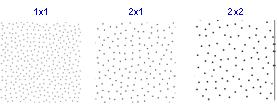
What’s New of Patch20191105 for EagleRIP5150
December 2019
1. Increased the output size from 2,000mm x 2,000mm to 2,100mm x 2,100mm.
2. Added 133lpi @ 5080dpi and 100/110/120lpi @ 2540dpi dots in FlexoRound Balance screening.
3. Improved the accuracy of cropping position and dimension in Ganging.
4. Support files with size larger than 4GB.
5. Fixed some other bugs.
What’s New in EagleRIP Flexo 5.1 (5150)
March 2019
1. Fixed the bug which the transparence was lost after RIP.
2. FlexoRound Balance 1 & 2 screening support 100lpi, 110lpi,120lpi on 2540dpi, and 133lpi on 5080dpi with patches,the total list is as following:
Resolution (DPI) | Frequency (LPI) | |
FlexoRound 1, FlexoRound 2 | FlexoRound Balance 1, FlexoRound Balance 2 | |
2400 | 40/50/65/87/100/110/120/133/150/165/175/200 | 133/150/165/175/200 |
2540 | 40/50/65/87/100/110/120/133/150/165/175/200 | 100/110/120/133/150/165/175/200 |
2800 | 40/50/65/87/100/110/120/133/150/165/175/200 | 133/150/165/175/200 |
3200 | 40/50/65/87/100/110/120/133/150/165/175/200 | 133/150/165/175/200 |
3600 | 40/50/65/87/100/110/120/133/150/165/175/200 | 133/150/165/175/200 |
4000 | 40/50/65/87/100/110/120/133/150/165/175/200 | 133/150/165/175/200 |
4800 | 40/50/65/87/100/110/120/133/150/165/175/200 | 133/150/165/175/200 |
5080 | 40/50/65/87/100/110/120/133/150/165/175/200 | 133/150/165/175/200 |
5600 | 40/50/65/87/100/110/120/133/150/165/175/200 | 175/200 |
6000 | 40/50/65/87/100/110/120/133/150/165/175/200 | 175/200 |
7200 | 40/50/65/87/100/110/120/133/150/165/175/200 | 175/200 |
8000 | 40/50/65/87/100/110/120/133/150/165/175/200 | 175/200 |
9600 | 40/50/65/87/100/110/120/133/150/165/175/200 | 175/200 |
The frequency in red at above table does not support miraclecell function. The frequency in green is new added with patches.
What’s New in EagleRIP Flexo 5.1 (5150)
March 2018
1.Supports the limitation of maximum output page size and resolution in license code.
2. Fix bugs (RIP is closed when process some of PDF files without rotation in special parameters).
What’s New in EagleRIP Flexo 5.1 (5130)
October 2017
1.Supports to crop page bitmap in manual ganging function. (bitmap should be generated by 1 Bit TIFF template and separated)
2. Supports to save the cropped bitmap as a 1 Bit TIFF file. (bitmap should be generated by 1 Bit TIFF template and separated)
3. Supports to overlap page bitmaps in manual ganging function, supports to arrange up and down relationship of the overlapped bitmaps. (bitmap should be generated by 1 Bit TIFF template and separated)
4. Supports to modify the surface size in ganging window.
5. RealDot Viewer is an option of EagleRIP Flexo 5.1 license code, you needn't a separated license code for RealDot Viewer if the code of EagleRIP Flexo 5.1 contains this option. RealDot Viewer needs to be installed on the same computer as EagleRIP Flexo 5.1.
6. Supports to remind when the EagleRIP option will be expired within 15 days.
7. Please upgrade your license code of EagleRIP Flexo 5.0 to use EagleRIP Flexo 5.1.
What’s New in EagleRIP Flexo 5.0 (5020)
July 2016
1. Update to the latest RIP kernel, improve the PDF compatibility.
2. Support Korean GUI.
3. Supports lower frequency for example 40/50/65/87lpi, FlexoRound screening supports 40/50/65/87/100/110/120/133/150/165/175/200 lpi for each resolution.
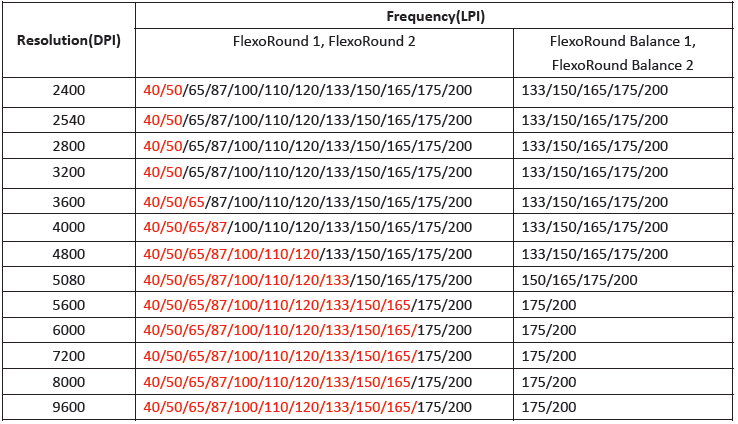 The frequency in red at above table does not support miracle cell function.
The frequency in red at above table does not support miracle cell function.
What’s New in EagleRIP Flexo 5.0 (5013)
July 2015
1. Update to the latest RIP kernel, improvethe PDF compatibility.
2. Adopt license code for encryption insteadof hardware dongle.
3. Support FlexoRound screening: New screening technology for flexo printing, pure round dot shape with 7.5 degrees offset.
4. Support optional FlexoRound Balance screening:On highlight, based on AM screening technology, we adopt dots with different sizes small, medium and large, increase gray level. This special technology can break the limitation of highlight dots in flexo printing and reproduce 1% or smaller dot.
5. Support optional Miracle Cell technology: increase ink density of shadow in flexo printing.
6. On shadow, based on FM screening technology, adds extract tiny dots in the shadow, this special technology greatly improves the shortage of insufficient solid ink of flexoprinting, and get a excellent print quality.
7. Support Real dot preview tool: RealDot Viewer, an essential checking tool. By browsing all the details of the real doton the monitor, to do the final check before printing, so as to secure the output file on flexo CTP plate is perfect without any error.
8. Only support TIFF and Winprint device driver.
9. Support Spanish GUI.
10. How to install EagleRIP Flexo 5.0 in your existing OS?
You need to uninstall the EagleRIP old version such as v4.5/4.3/4.2/4.01/4.0.
Run "AutoRun.exe" file of EagleRIP Flexo 5.0 and click on "Install EagleRIP" to install EagleRIP 5.0.
Please note that EagleRIP Flexo 5.0 only supports TIFF/Winprint device driver.
Any technical problem, please contact us GAsupport@founder.com.
1. PostScript 3 and PDF 1.7 RIP with native PDF interpreter
Supports PDF 1.7 document features including transparency, embedded ICC Profiles, 128-bit encryption, JPEG2000 filter etc.
2. TIFF 1-bit output
Productive ROOM (RIP Once, Output Many) solution accepted by digital proofing, CTF and CTP workflow solutions.
Driver can generate 1-bit TIFF file with no compression and CCITT GROUP4, or 8-bit TIFF file with no compression, LZW and Packbits.
3. Fast and flexible screen preview and dot preview
4. Built-in automatic ganging and manual ganging
5. Screening
13 built-in screen shapes: Euclidean Round, Rhomb, Ellipse, Diamond, Pure Round, Sharp Ellipse, Square, Gravure and FM screening.
EagleAM: Supports 2400dpi/2540/3657dpi, Round and Pure Round dot shapes. Adopts new screening technology, plus or minus 7.5 degrees based on previous angle.
FlexoRound: New screening technology for flexoprinting, pure round dot shape with 7.5 degrees offset.
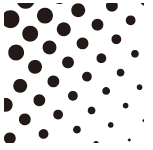
Optional Screenings:
EagleFM: Second-order FM Screening technology using variable dot size and variable spacing, controls the randomicity of dots.
EagleFAM: Supports hybrid FM/AM Screening. Uses EagleAM screening in midtones and adopts FM Screening in highlights and shadows.
EagleAGS: Accurate Gravure Screening, designed especially to improve the quality of gravure printing.
EagleAM-F: High screen frequency for Newspaper printing, special dot shape to avoid ink mist problem.
FlexoRound Balance: On highlight, we adopt dots with different sizes – small, medium and large, increase gray level. This special technology breaks the limitation of highlight dots in flexo printing, reproduce 1% or smaller dot.

Miracle Cell technology: Increase ink density of shadow in flexo printing, this special technology greatly improves the shortage of insufficient solid ink of flexo printing.
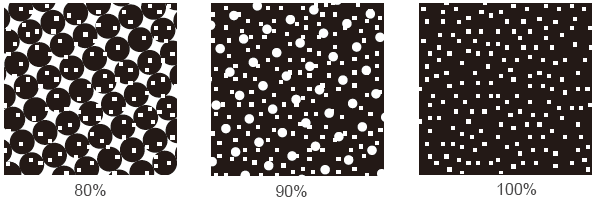
6. Supports TrueType and CID font and better performance of Asian fonts
7. Flexible network printing: NT Pipe, Apple Talk & HotFolder
8. Optional CIP3 output plug in enables to produce PPF filewhich reduce make-ready times and wastage.
9. Tifflow plugin for 1 bit TIFF PostRIP imposition workflow solution
10. RealDot preview tool
RealDot Viewer, an essential checking tool. By browsing all the details of the real dot on the monitor, to do the final check before printing, so as to secure the output file on flexo CTP plate is perfect without any error.
11. SDK (Software Developer’s Kit) available for OEMs
12. Support language of GUI
English, Simplified Chinese / 简体中文, Traditional Chinese / 繁体中文, German / Deutsche, Spanish / Español, Korean/ 한국어, Japanese / 日本語.
Flexo screening supports most resolutions and frequencies as below
Resolution (DPI) | Frequency (LPI) | |
FlexoRound 1 / 2 | FlexoRound Balance 1 / 2 | |
2400 | 40/50/65/87/100/110/120/133/150/165/175/200 | 133/150/165/175/200 |
2540 | 40/50/65/87/100/110/120/133/150/165/175/200 | 100/110/120/133/150/165/175/200 |
2800 | 40/50/65/87/100/110/120/133/150/165/175/200 | 133/150/165/175/200 |
3200 | 40/50/65/87/100/110/120/133/150/165/175/200 | 133/150/165/175/200 |
3600 | 40/50/65/87/100/110/120/133/150/165/175/200 | 133/150/165/175/200 |
4000 | 40/50/65/87/100/110/120/133/150/165/175/200 | 133/150/165/175/200 |
4800 | 40/50/65/87/100/110/120/133/150/165/175/200 | 133/150/165/175/200 |
5080 | 40/50/65/87/100/110/120/133/150/165/175/200 | 133/150/165/175/200 |
5600 | 40/50/65/87/100/110/120/133/150/165/175/200 | 175/200 |
6000 | 40/50/65/87/100/110/120/133/150/165/175/200 | 175/200 |
7200 | 40/50/65/87/100/110/120/133/150/165/175/200 | 175/200 |
8000 | 40/50/65/87/100/110/120/133/150/165/175/200 | 175/200 |
9600 | 40/50/65/87/100/110/120/133/150/165/175/200 | 175/200 |
The screening data in red in above table does not support Miracle Cell.
EagleRIP Flexo supports flexo screening and Miracle Cell techonology
FlexoRound: New screening technology for flexo printing, pure round dot shape with 7.5 degrees offset.

FlexoRound Balance: On highlight, we adopt dots with different sizes - small, medium and large, increase gray level. This special technology breaks the limitation of highlight dots in flexo printing, reproduce 1% or smaller dot.

Miracle Cell technology: Increase ink density of shadow in flexo printing, this special technology greatly improves the shortage of insufficient solid ink of flexo printing.

CPU: Intel (R) i7
Memory: 4G or above
Hard Disk: 200G free space
Display: 1024 x 768 Color
Network: 100MB Ethernet
OS: Windows 7/8/10/Windows 2012